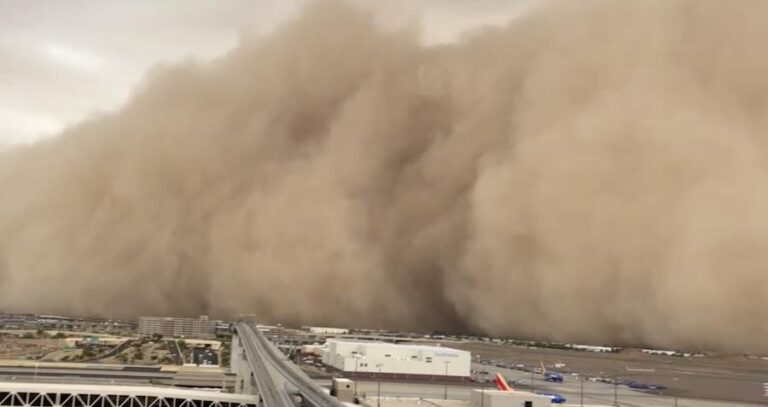A powerful haboob dust storm swept across Phoenix on Tuesday, blanketing the city in a thick veil of dust and dramatically reducing visibility. The severe weather event led to widespread power outages affecting thousands of residents and forced significant delays at Phoenix Sky Harbor International Airport. Emergency services and utility crews are working diligently to restore normalcy as officials warn of continuing hazardous conditions throughout the day.
Haboob Dust Storm Sweeps Through Phoenix Triggering Widespread Power Outages
The intense haboob storm that struck Phoenix brought with it a thick wall of dust and debris, drastically reducing visibility and disrupting daily life across the metro area. The powerful gusts led to widespread power outages affecting thousands of homes and businesses, leaving residents in the dark during the peak of the afternoon. Emergency services urged caution as streets became hazardous, with numerous traffic accidents reported due to the sudden drop in visibility.
In addition to the outages, Sky Harbor International Airport experienced significant delays and cancellations, impacting hundreds of travelers. Ground operations were temporarily halted as crews scrambled to manage the dusty conditions. Key impacts included:
- Over 15,000 customers without power for several hours
- Flight delays averaging 2-3 hours
- Visibility minimums dropping below 200 feet
- Increased emergency calls related to traffic accidents and health issues
| Affected Sector | Impact | Estimated Restoration |
|---|---|---|
| Residential Areas | Power Outages, Limited Visibility | 6-12 Hours |
| Transportation | Flight Delays, Road Accidents | Ongoing until Dust Subsides |
| Emergency Services | Increased Calls, Traffic Management | Active Response |
Impact on Phoenix Sky Harbor Airport Flight Operations and Passenger Delays
Operations at Phoenix Sky Harbor Airport were heavily disrupted as the haboob dust storm swept across the valley, reducing visibility to near zero and prompting temporary ground stops. Multiple flights experienced significant delays, with some airlines facing cancellations due to safety concerns linked to the severe weather. Passengers reported extended wait times both on the tarmac and inside congested terminals as airline staff worked frantically to manage rebooking and accommodate affected travelers.
Key impacts included:
- Over 50 flights delayed or canceled within a four-hour span
- Temporary closure of some runways until dust settled
- Increased taxi times as pilots navigated low-visibility conditions
- Massive passenger backlog causing crowded waiting areas
| Flight Status | Number of Flights | Average Delay |
|---|---|---|
| Delayed | 42 | 90 minutes |
| Canceled | 11 | N/A |
| On Time | 27 | 0 minutes |
Emergency Response Efforts and Utility Company Strategies to Restore Power
Utility companies rapidly deployed specialized crews to the most affected neighborhoods in Phoenix, prioritizing critical infrastructure such as hospitals and emergency services. Emergency response teams coordinated closely with city officials to implement immediate safety measures, including traffic control and public alerts regarding ongoing power restoration efforts. Mobile command centers were set up to manage real-time data and streamline communication between field workers and control rooms, ensuring swift identification of downed power lines and damaged transformers caused by the intense dust storm.
Strategic restoration plans were implemented with an emphasis on minimizing outages and preventing future incidents. These included:
- Preemptive inspections and reinforcement of vulnerable grid sections
- Utilization of drone technology to assess damage in hard-to-reach areas
- Deployment of temporary power solutions such as generators in hotspot zones
- Enhanced customer communication via social media and emergency notification systems
Utility operators emphasized their commitment to resilience by accelerating upgrades to smart grid technologies, improving fault detection, and automating reactive responses to natural disasters like the haboob.
| Action | Purpose | Status |
|---|---|---|
| Grid Damage Assessment | Identify outages and hazards | Ongoing |
| Crew Deployment | Restore critical power | In progress |
| Customer Alerts | Inform public of restoration timeline | Active |
| Smart Grid Upgrades | Increase future resilience | Planned |
Safety Tips and Preparedness Measures for Residents Facing Severe Dust Storms
Residents should take immediate action to protect themselves during severe dust storms:
- Stay indoors and keep windows and doors tightly closed to minimize exposure to dust particles.
- Use air purifiers or damp cloths to reduce indoor dust levels and improve air quality.
- Wear N95 masks if venturing outside, especially for individuals with respiratory conditions.
- Avoid driving unless absolutely necessary; reduced visibility and road hazards pose significant risks.
Preparedness is key to minimizing the disruption and health risks caused by haboob dust storms:
| Preparedness Measure | Recommended Action |
|---|---|
| Emergency Kit | Include masks, bottled water, flashlights, and first-aid supplies |
| Power Outages | Have backup power sources and keep devices fully charged |
| Transportation Plans | Stay updated on road closures and airport delays before travel |
| Health Precautions | Monitor symptoms and seek medical help if breathing difficulties arise |
Key Takeaways
As Phoenix begins to recover from the widespread impact of the haboob dust storm, authorities continue to assess the full extent of power outages and transportation disruptions. Utility crews are working around the clock to restore electricity to affected areas, while airport officials coordinate to manage delayed flights and ensure passenger safety. Residents are advised to stay informed through official channels as the situation develops, and to take precautions against ongoing dust and reduced visibility. The storm serves as a stark reminder of the region’s vulnerability to extreme weather events and the importance of emergency preparedness.







